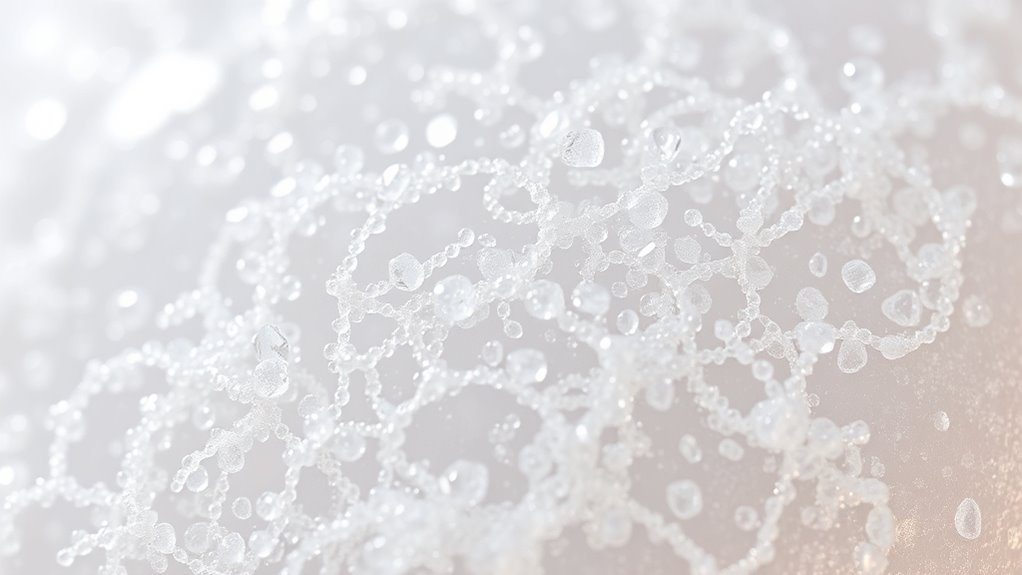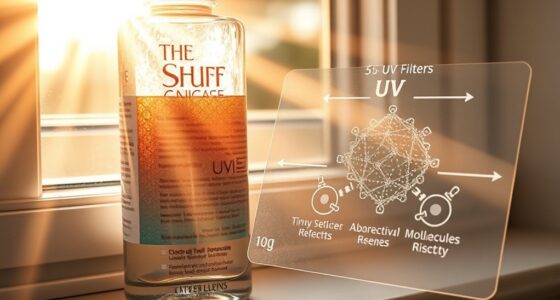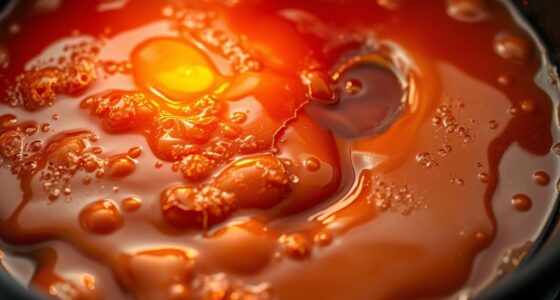Skincare acids like AHAs and BHAs work at the molecular level by dissolving the bonds holding dead skin cells together, promoting exfoliation. AHAs target surface layers, revealing smoother, brighter skin, while BHAs penetrate deeper into pores to clear out oil and debris. This process helps renew your skin and improve texture. To understand how to optimize their use and protect your skin’s barrier, keep exploring further insights.
Key Takeaways
- AHAs and BHAs dissolve the bonds (desmosomes and lipids) holding dead skin cells together, promoting exfoliation.
- AHAs target surface cells, breaking down extracellular matrix components to reveal smoother skin.
- BHAs penetrate pores, dissolving sebum and keratin plugs to clear out blockages.
- Both acids lower skin pH temporarily, activating enzymes that aid in cell turnover.
- Proper formulation maintains pH balance, ensuring effective exfoliation while protecting the skin barrier.

Have you ever wondered how skincare acids can transform your complexion? These powerful ingredients work at a molecular level to reveal smoother, brighter skin, but understanding how they do it can make your routine more effective.
Skincare acids transform your complexion by revealing smoother, brighter skin at a molecular level.
When you apply acids like AHAs and BHAs, you’re engaging in a delicate process that involves maintaining your skin’s pH balance and strengthening your skin barrier. The pH balance refers to the acidity level of your skin’s surface, which normally sits around 4.5 to 5.5. This slightly acidic environment helps keep bacteria at bay and supports the natural functions of your skin.
When acids are introduced, they temporarily lower the pH, creating an environment that promotes exfoliation but also requires careful balance to prevent irritation or barrier disruption. Proper formulation considerations, like formulation pH, are crucial to ensure acids work effectively without damaging your skin.
The skin barrier is your first line of defense, protecting against pollutants, bacteria, and moisture loss. Applying acids without regard for this barrier can lead to dryness, redness, or increased sensitivity. That’s why understanding how acids interact with your skin’s pH balance is vital.
When used correctly, AHAs and BHAs help to gently dissolve the bonds holding dead skin cells together, encouraging their removal. This process reveals newer, healthier skin beneath and reduces the appearance of fine lines, uneven tone, and dullness.
Because acids work at a molecular level, they penetrate the skin differently—AHAs mainly target surface cells, making them ideal for exfoliating the outermost layer, while BHAs penetrate deeper to clear out pores and reduce oiliness.
However, if your skin’s pH isn’t properly maintained, the acids can disrupt your skin barrier, leading to irritation or increased sensitivity. That’s why many skincare formulations are designed to be pH-balanced, ensuring the acids work effectively without compromising your skin’s health.
Additionally, maintaining a healthy skin barrier helps optimize the efficacy of acids and minimizes adverse effects, emphasizing the importance of barrier repair in skincare routines.
When your skin barrier is intact and your pH is in balance, acids can perform their exfoliating magic while supporting skin renewal and hydration. Proper moisturization after applying acids helps restore the pH and reinforce the barrier, preventing over-exfoliation.
Ultimately, understanding the role of pH balance and barrier health lets you harness the full benefits of skincare acids, giving you smoother, more radiant skin with less risk of irritation.
Frequently Asked Questions
Can Acids Cause Long-Term Skin Damage?
You might wonder if acids can cause long-term skin damage. If you use acids with high concentration or disrupt your skin’s pH balance, you risk irritation or damage over time.
To avoid this, choose products with appropriate acid concentration, follow recommended usage, and guarantee your skin’s pH stays balanced.
Proper application helps you reap benefits without risking long-term harm.
How Do Acids Differ in Exfoliating Strength?
Sure, because all acids are basically the same, right? Not quite. You’ll notice that some acids have a stronger exfoliating effect, thanks to their lower pH levels and deeper exfoliation depth.
AHAs tend to gently polish the surface, while BHAs go deeper into pores. So, if you want a mild glow or a serious purge, understanding how acids differ in strength helps you choose wisely.
Are Acids Safe for Sensitive Skin Types?
You might wonder if acids are safe for sensitive skin. While they can cause irritation if not used properly, many acids are gentle enough for sensitive skin types.
To prevent acid reactions, start with lower concentrations and patch test first. Look for soothing formulas with calming ingredients, and always follow with sunscreen.
When used correctly, acids can improve your skin’s texture without causing unnecessary irritation.
What Are the Signs of Acid Overuse?
Imagine using acids daily and noticing increased redness, dryness, or irritation—that’s a sign of acid overuse.
If you experience acid sensitivity, your skin may become more reactive, and pH imbalance can occur, compromising your skin’s barrier.
You might also notice peeling or stinging.
These symptoms indicate you’re overdoing it, so reduce usage and give your skin time to recover.
Always listen to your skin’s signals to avoid damage.
How Should Acids Be Layered With Other Skincare Products?
When layering acids with other skincare products, you should focus on pH balancing and ingredient compatibility.
Apply acids first to verify effective exfoliation, then wait a few minutes for pH to stabilize before applying moisturizers or treatments.
Avoid combining acids with retinols or vitamin C immediately, as this can cause irritation.
Always patch test new combinations and listen to your skin’s response for safe, effective layering.
Conclusion
Understanding how AHAs and BHAs exfoliate at the molecular level helps you choose the right skincare. Did you know that regular use can boost cell turnover by up to 14%? That’s like turning back the clock on your skin’s aging process. By incorporating these acids into your routine, you’re not just improving your skin’s texture—you’re actively promoting a brighter, smoother complexion. So, embrace these powerful molecules and let your skin reveal its natural radiance.









